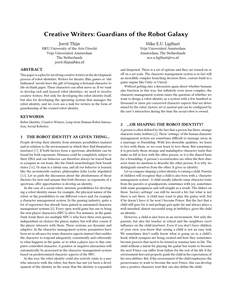This paper is a plea for involving creative writers in the developmentprocess of robot identities. Writers for theatre, film, games or ’old-fashioned’ novels have the gift of bringing a fictional character tolife on blank paper. These characters can often move us. If we wantto develop rich and layered robot identities, we need to involvecreative writers. Not only for developing the robot identity itself,but also for developing the operating system that manages therobot identity, and we even see a task for writers in the form ofguardianship of the created robot identity
DOCUMENT

Maintaining the child-robot relationship after a significant break, such as a holiday, is an important step for developing sustainable social robots for education. We ran a four-session user study (n = 113 children) that included a nine-month break between the third and fourth session. During the study, participants practiced math with the help of a social robot math tutor. We found that social personalization is an effective strategy to better sustain the child-robot relationship than the absence of social personalization. To become reacquainted after the long break, the robot summarizes a few pieces of information it had stored about the child. This gives children a feeling of being remembered, which is a key contributor to the effectiveness of social personalization. Enabling the robot to refer to information previously shared by the child is another key contributor to social personalization. Conditional for its effectiveness, however, is that children notice these memory references. Finally, although we found that children's interest in the tutoring content is related to relationship formation, personalizing the topics did not lead to more interest in the content. It seems likely that not all of the memory information that was used to personalize the content was up-to-date or socially relevant.
MULTIFILE

Wat is de beroepsidentiteit van sociaal werk, wat behoort zij te zijn? Sociaal werk wordt wel omschreven als een professie maar ook als een ambacht, vaak zonder duidelijk onderscheid tussen en wellicht zelfs door impliciete gelijkstelling van deze kwalificaties. Met behulp van de ideaaltypische benadering kan echter worden aangetoond dat deze twee typen beroepen niet alleen veel overeenkomsten delen maar ook op enkele punten fundamenteel van elkaar verschillen. Op basis van het werk van Freidson (2001) en Sennett (2008) kan worden aangetoond dat het ideaaltypische doel van professies het realiseren van een abstracte waarde (zoals rechtvaardigheid) is, terwijl ambachten gericht zijn op het manipuleren van concrete materialen (bijvoorbeeld steen). Bijgevolg zijn (enkel) professies beroepen met een morele identiteit. In alle zelfdefinities van sociaal werk is deze morele identiteit, deze humanitaire kern aanwezig (zie bv. IFSW, NVMW). Daarom moet sociaal werk worden beschouwd als een professie en niet als een ambacht. Dit is niet louter een academische discussie maar beïnvloedt bijvoorbeeld de positie van dit beroep in de samenleving, zoals aan de hand van de ministeriële richtlijnen betreffende Welzijn Nieuwe Stijl kan worden geïllustreerd.
DOCUMENT
